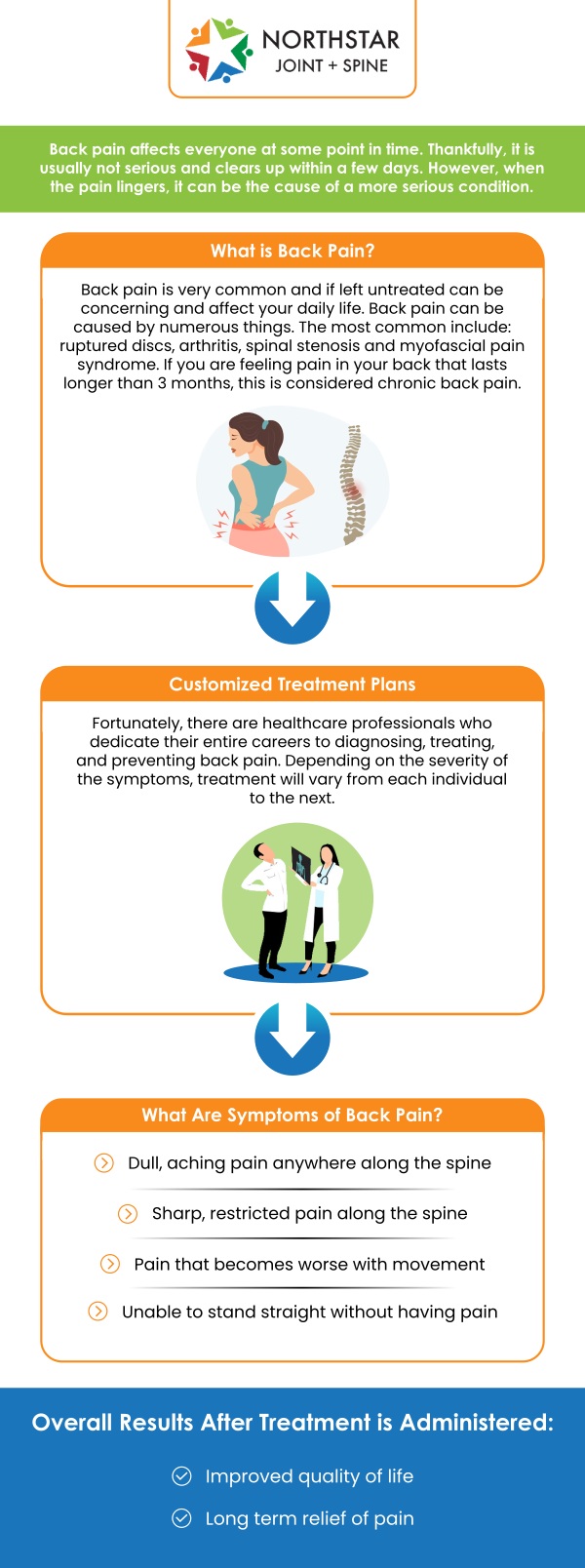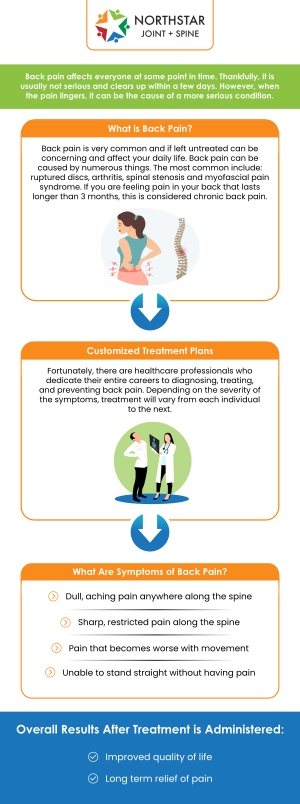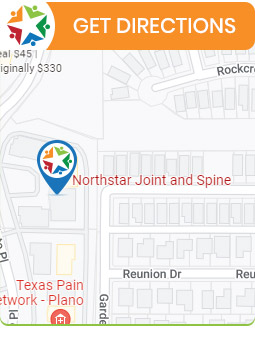Back Pain and Sciatica Struggles: What You Should Know
Back pain and sciatica can significantly impact your daily life, causing discomfort and limiting mobility. The pain may radiate down the legs, often making simple tasks seem difficult. If left untreated, these conditions can worsen over time, affecting your overall well-being. At Northstar Joint and Spine, Board Certified Dr. Robert J. Nocerini, MD offers professional care to help alleviate pain and restore mobility. For more information, contact us today or schedule an appointment online. We are conveniently located at 7704 San Jacinto Pl Suite #200 Plano, TX 75024.


Table of Contents:
What are the main causes of back pain and sciatica?
What are the symptoms of sciatica back pain?
How am I able to tell if my back pain is sciatica?
What lifestyle changes can help manage back pain and sciatica?
Overcome Back Pain and Sciatica Struggles with Board-Certified Dr. Robert J. Nocerini, MD at Northstar Joint and Spine
Back pain and sciatica are associated with a variety of potential causes. However, they often begin with pressure on the lower spinal nerves, including the sciatic nerve, which runs from the lower back and along through the hips and legs. One common cause of these conditions is a herniated or bulging disc that shifts out of place and begins to irritate the nerve roots nearby. Degenerative disc changes that develop with age can also reduce space in the spine, making nerve compression more likely to occur. Structural imbalances, such as poor posture or uneven weight distribution, can strain the lower back over time and lead to the kind of nerve involvement seen with sciatica.
Other contributing factors may include muscular tightness in the lower back or hips, which have the potential to pull on the spine and amplify discomfort in the surrounding nerves. Long hours spent sitting can make things worse, as can repetitive strain from lifting or twisting. The specialists at Northstar Joint and Spine focus on identifying where that pressure is coming from and how to relieve it, whether it stems from disc changes, joint dysfunction, or muscular imbalance.
When back pain is linked to sciatica, it will usually extend beyond just the lower spine. Sciatica pain often stretches down the buttock and into the leg, and sometimes all the way to the calf or foot, depending on how far the nerve is irritated. Unlike general muscle soreness or tension, sciatica may feel sharper, potentially presenting as a jolt that runs down the leg, or a feeling of pins and needles that doesn’t go away with rest. These symptoms usually affect one side and may be accompanied by weakness or difficulty moving the leg. Another sign that the pain stems from sciatic nerve irritation is when simple tasks like bending, sitting, or rising from a chair seem to make things worse. If the discomfort moves in a predictable path along the nerve and doesn’t respond to typical muscle-focused care, then deeper nerve involvement is likely. The specialists at Northstar Joint and Spine use a combination of patient history and imaging when necessary to separate sciatic nerve pain from other causes of lower back discomfort.
Sciatica symptoms tend to begin in the lower back and radiate down one leg, sometimes reaching the foot. The pain may present as a deep ache, a sharp shooting sensation, or a burning feeling along the length of the sciatic nerve. For some, it presents as a constant throb; for others, it comes in waves. These nerve-related symptoms often affect one side more than the other and can vary in intensity from mild to severely limiting. Some individuals also experience tingling, numbness, or a sense of weakness in the affected leg. Walking or climbing stairs may feel less stable, and certain movements can intensify the discomfort if the nerve is under pressure. While back pain alone doesn’t always indicate sciatica, when it’s paired with these distinct leg symptoms, nerve involvement is usually part of the picture. That combination helps providers at Northstar Joint and Spine tailor treatment to the root of the problem, rather than just the surface symptoms.
Managing sciatica and general back pain often starts with small, consistent changes in daily habits. Regular low-impact movement and exercise can improve circulation and help prevent the stiffness that often fuels nerve irritation. Maintaining proper posture while working, especially during long hours at a desk, can reduce strain on the spine and limit pressure on the lower back. The use of supportive seating material and breaks throughout the day to move around all contribute to easing discomfort over time.
Core strengthening exercises can also help to cause a reduction of stress on the spine and surrounding joints. Avoiding prolonged inactivity can prevent muscles from tightening around the lower back, which can trigger or worsen symptoms. Weight management, balanced sleep positions, and taking care while lifting or moving can all support long-term back health. The team at Northstar Joint and Spine can work with patients to direct them towards positive health and lifestyle changes, pairing them with focused treatments that address the underlying issue.
At Northstar Joint and Spine, Board-Certified Dr. Robert J. Nocerini, MD, offers advanced solutions for patients suffering from back pain and sciatica. With over 26 years of medical experience, he combines his board certifications in Pain Medicine and Anesthesiology to deliver precise, evidence-based treatments. Dr. Nocerini emphasizes accurate diagnosis, customized care plans, and minimally invasive options to help patients regain comfort, mobility, and long-term relief.
• Focuses on identifying and treating the root cause of pain
• Utilizes state-of-the-art diagnostic and therapeutic techniques
• Provides comprehensive pain management in a supportive setting
• Integrates both modern and conservative treatment approaches
• Dedicated to improving each patient’s quality of life and functional recovery
Back pain and sciatica treatment are available at Northstar Joint and Spine. For more information, contact us today or schedule an appointment. We are conveniently located at 7704 San Jacinto Pl Suite #200 Plano, TX 75024. We serve patients from Plano TX, Willow Bend TX, Frisco TX, Allen TX, Addison TX, North Dallas TX, and surrounding areas.

Additional Services You May Need
▸ Back Pain
▸ Chronic Pain
▸ Epidural Steroid Injections
▸ Spinal Cord Stimulation
▸ Viscosupplementation
▸ Genicular Nerve Blocks
▸ Facet Injections
▸ Joint Injections
▸ Sacroiliac Joint Injections
▸ Lumbar and Cervical
▸ Facet Medial Branch Blocks
▸ Diagnostic Nerve Blocks
▸ Medication Management
▸ Neck Pain Doctor
▸ Diabetic Peripheral Neuropathy
▸ Headaches
▸ Suboxone
▸ Botox for Migraines
▸ Peripheral Nerve Stimulation
▸ Spine
▸ Joints
▸ Muscles
▸ Bones

Additional Services You May Need
▸ Back Pain
▸ Chronic Pain
▸ Epidural Steroid Injections
▸ Spinal Cord Stimulation
▸ Viscosupplementation
▸ Genicular Nerve Blocks
▸ Facet Injections
▸ Joint Injections
▸ Sacroiliac Joint Injections
▸ Lumbar and Cervical
▸ Facet Medial Branch Blocks
▸ Diagnostic Nerve Blocks
▸ Medication Management
▸ Neck Pain Doctor
▸ Diabetic Peripheral Neuropathy
▸ Headaches
▸ Suboxone
▸ Botox for Migraines
▸ Peripheral Nerve Stimulation
▸ Spine
▸ Joints
▸ Muscles
▸ Bones






